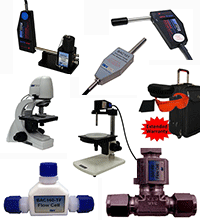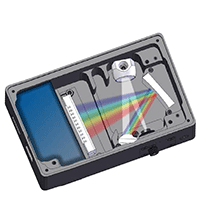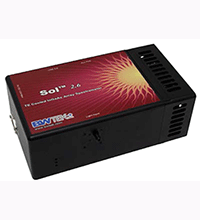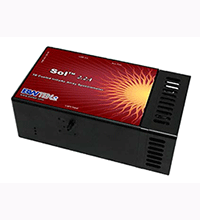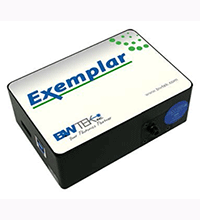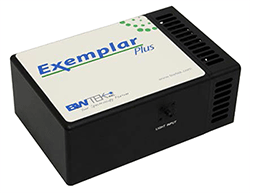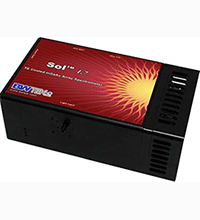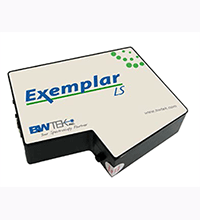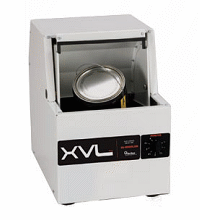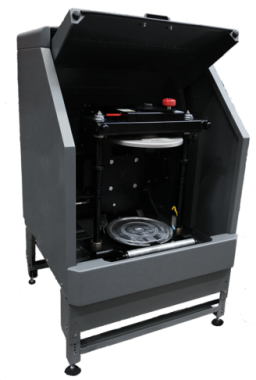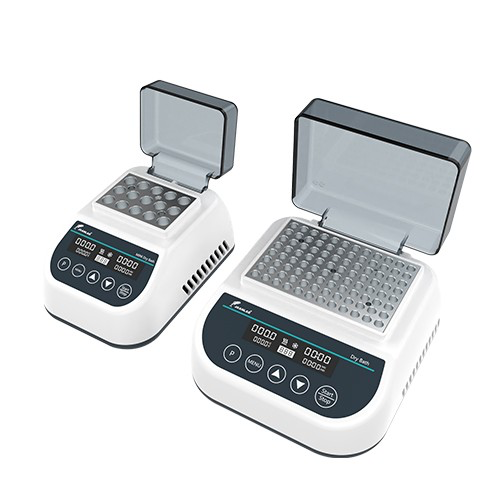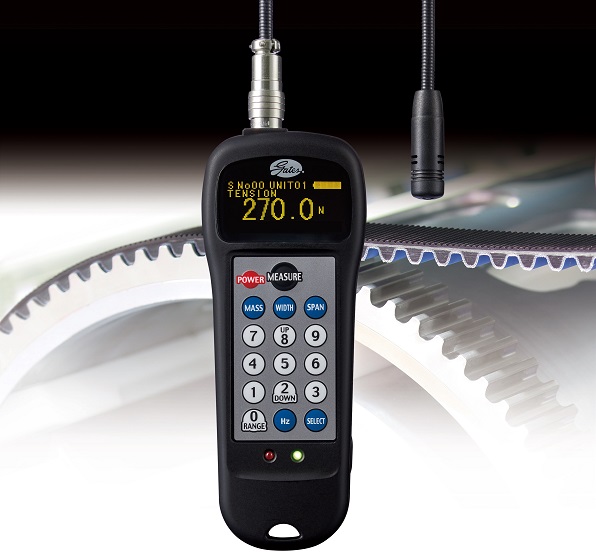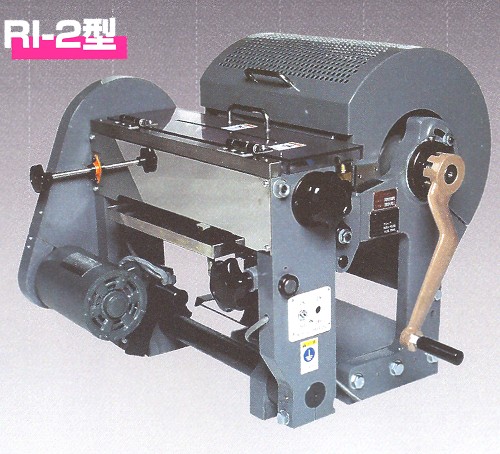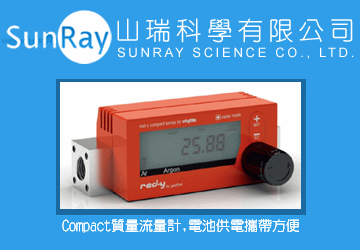|
Glacier® X 高性能光譜儀(含電子制冷器)
|
| Compact High Performance TE Cooled CCD Spectrometer

|
The Glacier® X is a TE Cooled linear CCD array spectrometer. It features a 2048 element detector, built-in 16-bit digitizer, and USB 2.0 interface. Compared to non-cooled CCD spectrometers, the Glacier® X offers higher dynamic range, significantly reduced dark counts, and superior long-term operation stability, making it ideal for low light level detection and long- term monitoring applications.
The Glacier® X is ideal for most UV, Vis, and NIR applications with spectral configurations from 200nm to 1050nm and resolutions between 0.2nm and 4.5nm. Custom configurations and application support are available for OEM applications. |
|
| |
| Applications: |
Features: |
Accessories: |
|
• UV, Vis, and NIR:
Spectroscopy / Spectroradiometry /
Spectrophotometry
• Wavelength Identification
• Absorbance
• Reflectance
• OEM Optical Instrumentation
|
• UV - NIR Ranges
• <0.2nm Resolution
• TE Cooled / Regulated
• 16-bit Digitizer
• 500 kHz Readout Speed
• Plug-and-play USB 2.0
• OEM Version Available
|
• Fiber Patch Cords
• Light Sources
• Cuvette Holders
• Inline Filter Holders
• Fiber Optic Probes
|
|
|
Software:
BWSpec™ is a spectral data acquisition software with a
wide range of tools that are designed to perform complex
measurements and calculations at the click of a button.It
allows the user to choose between multiple data formats
and offers optimization of scanning parameters,such as
integration time. In addition to powerful data acquisition
and data processing,other features include automatic dark
removal,spectrum smoothing,and manual/auto baseline
correction.
|

|
|
|
|
| Specifications: |
|
DC Power Input
|
5V DC @ < 1.5 Amps
|
|
AC Adapter Input
|
100 - 240VAC 50/60 Hz, 0.5A @ 120VAC
|
|
Detector Type
|
Response Enhanced Linear CCD Array
|
|
Pixels
|
2048 x 1 Elements @ 14μm x 200μm Per Element
|
|
Spectrograph f/#
|
3.2
|
|
Spectrograph Optical Layout
|
Crossed Czerny-Turner
|
|
Dynamic Range
|
300 (Typical)
|
|
Digitizer Resolution
|
16-bit or 65,535:1
|
|
Readout Speed
|
500 kHz
|
|
Data Transfer Speed
|
Up to 180 Spectra Per Second Via USB 2.0
|
|
Integration Time
|
5 ~ 65,535ms x Multiplier
|
|
External Trigger
|
Aux Port
|
|
Operating Temperature
|
15°C - 35°C
|
|
Operational Relative Humidity
|
85% Noncondensing
|
|
TE Cooling
|
14°C
|
|
Weight
|
~ 1.32 lbs (0.60 kg)
|
|
Dimensions
|
5in x 1.5in x 3.6in (127.0mm x 39.0mm x 90.7mm)
|
|
Computer Interface
|
USB 2.0 / 1.1
|
|
Operating Systems
|
Windows: XP, Vista, 7
|
|
| |
|
Technical Details
Fiber Coupler
 Secures Fiber to Ensure Repeatable Results Secures Fiber to Ensure Repeatable Results
By coupling a fiber optic to the SMA 905 adaptor, light will be guided to the slit and optically matched, ensuring reproducibility. For free space sampling, a diffuser or lens assembly can be connected directly to the SMA 905 adaptor.
|
 |
| |
|
Entrance Slit

Determines Photon Flux and Spectral Resolution
Light entering into a spectrometer’s optical bench is vignetted by a pre-mounted and aligned slit. This ultimately determines the spectral resolution and throughput of the spectrometer after grating selection. We offer a variety of slit widths to match your specific application needs: from 10µm - 200µm wide, with custom slits available.
|
|
SlitOption
|
Dimensions
|
Approx. Resolution
350-1050nm
|
|
10µm
|
10µm wide x 1mm high
|
~1.1nm
|
|
25µm
|
25µm wide x 1mm high
|
~1.4nm
|
|
50µm
|
50µm wide x 1mm high
|
~2.2nm
|
|
100µm
|
100µm wide x 1mm high
|
~4.3nm
|
|
200µm
|
200µm wide x 1mm high
|
call
|
|
Custom Slit Widths Available
|
|
|
| |
| Collimating Mirror
 Collimates and Redirects Light Towards Grating Collimates and Redirects Light Towards Grating
Both mirrors are f/# matched focusing mirrors coated with AlMg2, which produces approximately 95% reflectance when working in the UV-Vis spectrum. Aluminum (Al) provides reflectance and magnesium (Mg2) protects the aluminum from oxidation.
|
| |
| Diffraction Grating
 Diffracts Light, Separating Spectral Components Diffracts Light, Separating Spectral Components
The groove frequency of the grating determines two key aspects of the spectrometer’s performance: the wavelength coverage and the spectral resolution. When the groove frequency is increased, the instrument will achieve higher resolution, but the wavelength coverage will decrease. Inversely, decreasing the groove frequency increases wavelength coverage at the cost of spectral resolution.
The extension of the QE curve after the UV enhancement.
in optimizing the spectrometer’s performance. The blaze angle determines the maximum efficiency that the grating will have in a specific wavelength region.
|
| Best Efficiency |
Spectral Coverage
(nm) |
Grating |
|
UV / Vis
|
200-400
|
1800/250 |
|
UV / NIR
|
200-800
|
716/222 |
|
UV / Vis
|
250-600
|
1200/250 |
|
UV
|
280-370
|
3600/240 |
|
UV / NIR
|
300-900
|
600/400 |
|
UV / NIR
|
350-1050
|
700/530 |
|
Vis
|
380-750
|
900/500 |
|
Vis / NIR
|
400-800
|
1200/500 |
|
Vis / NIR
|
450-1050
|
830/800 |
|
Vis
|
530-700
|
1800/500 |
|
Vis / NIR
|
600-800
|
1714/650 |
|
Vis / NIR
|
750-1050
|
1200/750 |
| Custom Configurations Available |
|
|
| |
|
Focusing Mirror
 Refocuses Dispersed Light onto Detector Refocuses Dispersed Light onto Detector
DetectorBoth mirrors are f/# matched focusing mirrors coated with AlMg,which produces approximately 95% reflectance when working in the UV-Vis spectrum. Aluminum (Al) provides reflectance and magnesium (Mg2)
|
| |
| Array Detector
 Measures Entire Spectrum Simultaneously Measures Entire Spectrum Simultaneously
The Glacier® X features a 2048 x 1 linear TE Cooled CCD array detector with a 14µm pixel width and > 2000 active pixels. As the incident light strikes the individual pixels across the CCD, each pixel represents a portion of the spectrum that the electronics can then translate and display with a given intensity using BWSpec™ software.
The quantum efficiency (QE) and noise level of the array detector greatly influences the spectrometer’s sensitivity, dynamic range and signal-to-noise ratio. The spectral acquisition speed of the spectrometer is mainly determined by the detector response over a wavelength region.
|
|
Specifications
|
|
Wavelength Range
|
200nm - 1050nm
|
|
Pixels
|
2048
|
|
Pixel Size
|
14µm x200µm
|
|
Well Depth
|
~90,000 e-
|
|
Digitization Rate
|
500 kHz
|
|
 |
|
| |
| Thermoelectric Cooler
 Reduces Dark Noise and Increases Detection Limits Reduces Dark Noise and Increases Detection Limits
Cooling an array detector with a built-in thermoelectric cooler (TEC) is an effective way to reduce dark current and noise, as well as to enhance the dynamic range and detection limit.
When the CCD detector array is cooled from a room temperature of 25˚C down to 14˚C by the TEC, the dark current is reduced by a factor of 4 and the dark noise is reduced by a factor of 2. This allows the spectrometer to operate at longer exposure times and to detect weaker optical signals.
|
|
|




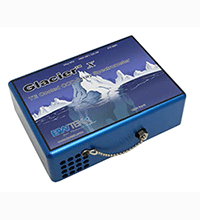






 Refocuses Dispersed Light onto Detector
Refocuses Dispersed Light onto Detector




